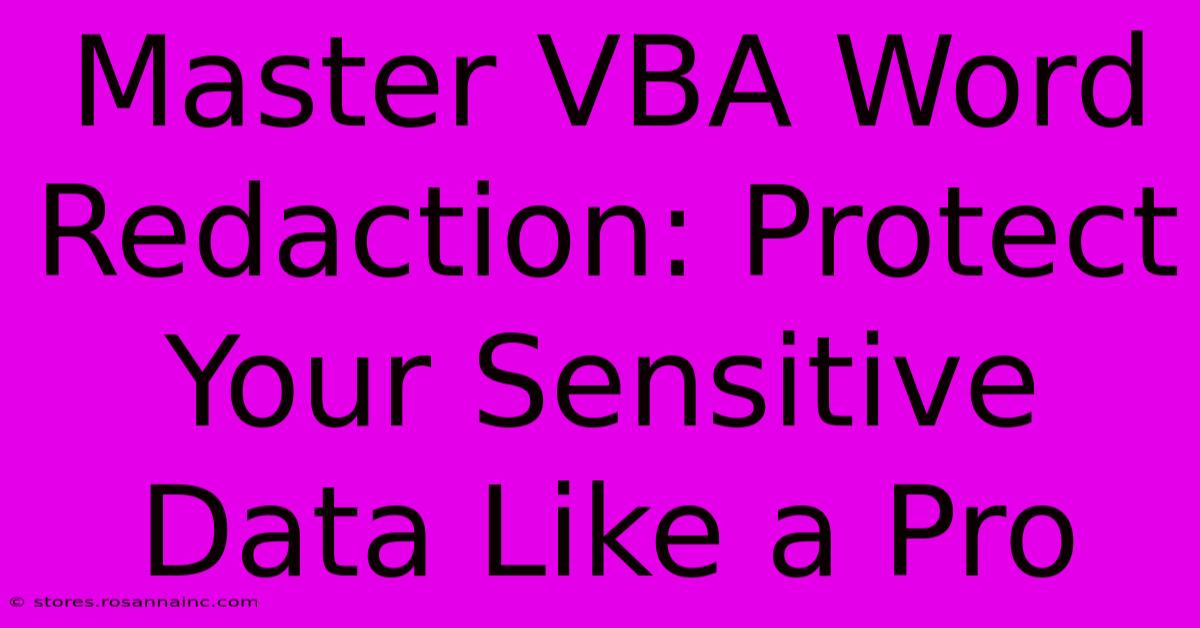Master VBA Word Redaction: Protect Your Sensitive Data Like A Pro

Table of Contents
Master VBA Word Redaction: Protect Your Sensitive Data Like a Pro
In today's digital age, protecting sensitive information is paramount. Whether you're a legal professional handling confidential documents, a business executive safeguarding proprietary data, or simply an individual concerned about privacy, mastering data redaction is crucial. While Word offers built-in redaction tools, they often fall short for complex scenarios. This is where VBA (Visual Basic for Applications) steps in, empowering you with the precision and automation needed to perform thorough and efficient redaction. This comprehensive guide will transform you into a VBA Word redaction expert, enabling you to protect your sensitive data like a pro.
Why VBA for Word Redaction?
Word's built-in redaction features are suitable for simple tasks, but they lack the flexibility and power required for complex redaction projects. VBA provides significant advantages:
- Automation: Process hundreds or even thousands of documents with automated redaction, saving countless hours.
- Precision: Target specific keywords, phrases, or patterns for accurate removal or obfuscation.
- Customization: Tailor redaction processes to your exact needs, handling various document formats and data types.
- Security: Implement robust redaction techniques to ensure irreversible data removal.
- Repeatability: Create reusable VBA macros for consistent redaction across multiple projects.
Understanding the Fundamentals of VBA Redaction
Before diving into specific code examples, let's grasp the core concepts:
- Find and Replace: VBA's powerful
FindandReplacemethods are the bedrock of redaction. These allow you to locate specific text strings and either delete them entirely or replace them with alternative characters. - Wildcards: Utilize wildcards like
*(matches any sequence of characters) and?(matches any single character) for flexible pattern matching. This allows for redaction of variations of a single term. - Regular Expressions: For even more advanced pattern matching, consider leveraging regular expressions. This provides highly flexible and sophisticated search capabilities.
- Object Model: Familiarize yourself with the Word object model. Understanding how to interact with documents, paragraphs, and selections is crucial for effective VBA redaction.
Practical VBA Code Examples for Redaction
Here are some practical examples to get you started. Remember to always test your code thoroughly on sample documents before applying it to sensitive materials.
Example 1: Removing Specific Keywords
This macro removes all instances of the keyword "Confidential":
Sub RemoveKeyword()
Dim doc As Document
Set doc = ActiveDocument
With doc.Content.Find
.Text = "Confidential"
.Execute Replace:=wdReplaceAll
End With
Set doc = Nothing
End Sub
Example 2: Redacting with Wildcards
This macro redacts any text starting with "SSN:" followed by any number of digits:
Sub RedactSSN()
Dim doc As Document
Set doc = ActiveDocument
With doc.Content.Find
.Text = "SSN:\d*" ' \d* matches any sequence of digits
.Execute Replace:=wdReplaceAll, ReplaceWith:="XXXXXXXXXX"
End With
Set doc = Nothing
End Sub
Example 3: More Robust Redaction with Regular Expressions
This example leverages regular expressions for more complex pattern matching (requires enabling the Microsoft VBScript Regular Expression object library):
Sub RedactEmail()
Dim doc As Document
Set doc = ActiveDocument
Dim regex As Object
Set regex = CreateObject("VBScript.RegExp")
With regex
.Global = True
.Pattern = "\b[A-Za-z0-9._%+-]+@[A-Za-z0-9.-]+\.[A-Z|a-z]{2,}\b" ' Email pattern
End With
doc.Content.Find.Execute Replace:=wdReplaceAll, ReplaceWith:="REDACTED"
Set doc = Nothing
Set regex = Nothing
End Sub
Advanced Techniques and Best Practices
- Version Control: Maintain versions of your documents before and after redaction for auditing purposes.
- Testing: Rigorous testing on sample data is crucial before applying your macros to sensitive materials.
- Error Handling: Implement error handling routines to gracefully manage unexpected situations.
- Security: Secure your VBA code and prevent unauthorized access.
Conclusion: Taking Control of Your Data Security
Mastering VBA for Word redaction empowers you to take control of your data security, ensuring sensitive information remains protected. By utilizing the techniques and code examples outlined in this guide, you can significantly enhance your redaction capabilities and safeguard your valuable data. Remember to prioritize thorough testing and always back up your documents before implementing any redaction procedures. With practice and refinement, you'll become a pro at protecting your sensitive data with the power of VBA.

Thank you for visiting our website wich cover about Master VBA Word Redaction: Protect Your Sensitive Data Like A Pro. We hope the information provided has been useful to you. Feel free to contact us if you have any questions or need further assistance. See you next time and dont miss to bookmark.
Featured Posts
-
The Ultimate Cheat Code For Email Marketing Wise Stamp Pro Promo Code
Feb 05, 2025
-
Caution These Top 10 Ads Will Make You Question Everything
Feb 05, 2025
-
Spotlight On Excellence How Side Lighting Transforms Cinematic Narratives
Feb 05, 2025
-
Unleash Your Inner Innovator With The Gel Inc Innovation At Your Fingertips
Feb 05, 2025
-
Saints And Lions In Gridiron Showdown Who Will Emerge Triumphant
Feb 05, 2025
